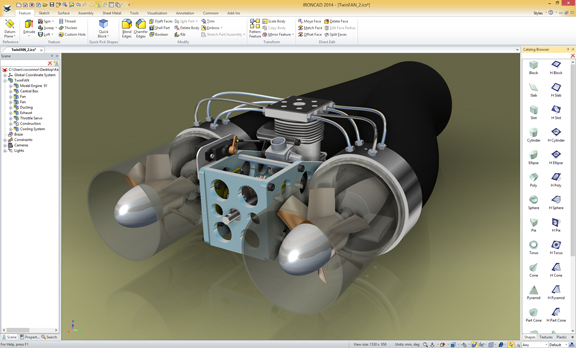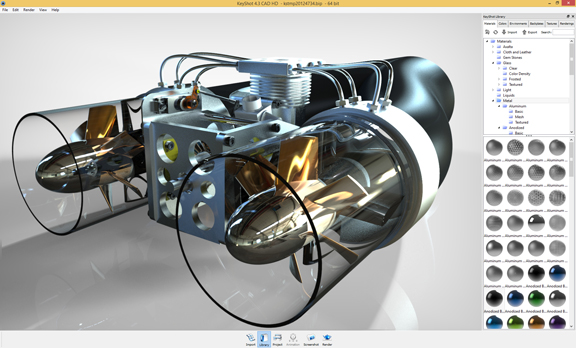February 12, 2014
Six or seven years ago, CAD users considered photorealistic visuals desirable, but not critical. Few would have outright rejected a 3D program because it doesn’t offer the option to instantly view the design in a virtual scene, complete with shadows, textures, and ground reflections.
But the flurry of CAD and rendering software partnerships in the last few years suggests a sea change. From small design shops to large manufacturers, more and more businesses are relying on 3D models to evaluate their products’ aesthetic appeal and commercial prospect. This elevates rendering from optional eye candy to essential tool, from cosmetic to vital.
In 2012, SpaceClaim, a direct modeler, struck up a partnership with Luxion KeyShot, a popular renderer. In late 2013, it also shook hands with Lagoa, a cloud-hosted renderer. Around the same time, IronCAD, a long-established CAD developer, inked an agreement with KeyShot. In addition to becoming an integrated renderer for SpaceClaim and IronCAD, KeyShot is now also an integrated renderer for GrabCAD, an online collaboration service provider and a 3D exchange community. Because GrabCAD also has an agreement with Lagoa, those who use GrabCAD Workbench, the company’s collaboration system, may also use Lagoa for rendering. (I get the feeling it might take flow chart to properly display all these crisscrossing partnerships.)
Traditionally Luxion KeyShot costs $995 to $3,995, depending on the features included. However, IronCAD offers access to an integrated version of KeyShot for roughly $600. Dubbed KeyShot for IronCAD, the product is available from IronCAD sales channels, including IronCAD resellers. The integration takes the form of a KeyShot launch tab that appears inside IronCAD’s design environment.
The associativity between IronCAD and KeyShot for IronCAD lets you hit the “update” button to transfer design changes from IronCAD to the rendered view in KeyShot. The limitation, however, is that KeyShot for IronCAD only opens KeyShot’s native BIP files; therefore, it encourages you to funnel your designs into KeyShot through IronCAD. The transfer to KeyShot preserves the IronCAD model tree inside the rendering environment.
Independent of KeyShot, IronCAD includes its own 3D visualization tools, based on HOOPS technology. The KeyShot integration offers a more comprehensive set of features for producing high-end visuals based on CAD models.
Cary O’Connor, IronCAD’s VP of marketing, said, “Offering an affordable low cost version of KeyShot to our IronCAD customers was a logical step to provide a wide variety of tools to meet their customers’ expectations when communicating concepts, bids, or final marketing collateral.”
IronCAD has also added links to downloadable content from partners and user communities. It currently lets you reach into 3D content from TraceParts, Cadenas, and GrabCAD. If you happen to have a GrabCAD Workbench account, you may also publish your designs directly to Workbench’s project space for collaboration.
For the next release, IronCAD R&D team is developing a set of tools for “design negotiation,” according to O’Connor, the “design negotiation” feature will offer a better alternative to simple markups, redlining, and annotation in asynchronous, collaborative design-change discussions, O’Connor explained. More details on this enhancement is expected to become public in April.
Subscribe to our FREE magazine, FREE email newsletters or both!
About the Author
Kenneth Wong is Digital Engineering’s resident blogger and senior editor. Email him at [email protected] or share your thoughts on this article at digitaleng.news/facebook.
Follow DE







